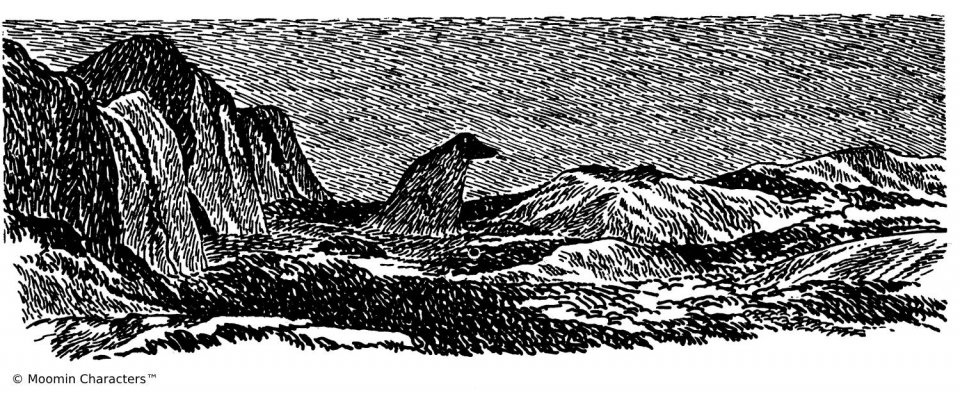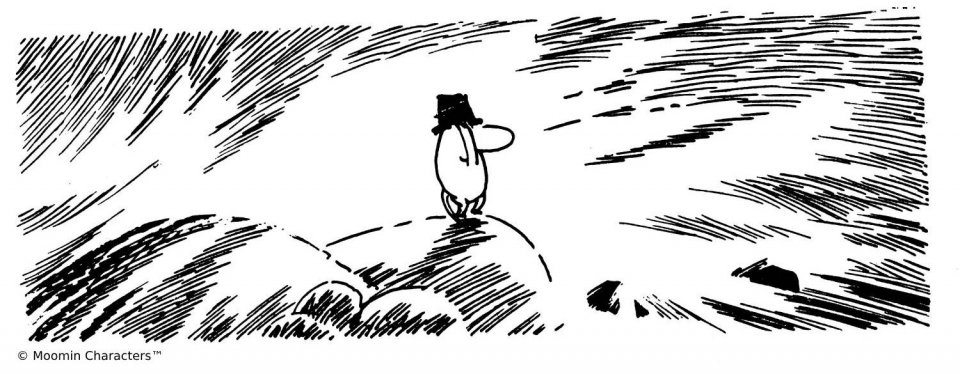Everything, actually, says Sanna Tirkkonen, a researcher who has studied Tove Jansson's work. Loneliness and exclusion, and overcoming them, are key themes in Jansson's classic stories.
Text by Sanna Tirkkonen Academy Research Fellow, Practical Philosophy, University of Helsinki, Images by Moomin Characters
Feelings of loneliness and alienation are central themes in Tove Jansson’s work. Loneliness is, in particular, present in the novel Moominpappa at Sea, though the themes of feeling left out and finding one’s place are also recurrent in many other Moomin stories.
In Jansson’s work, even inanimate nature acts as a reference to loneliness: the map of Moominvalley is bordered by the rugged Lonely Mountains, the Hattifatteners gather on a lonely island, and Moominpappa’s adventures are witnessed by a lonely moon. In Moominpappa at Sea, the loneliness of the Groke freezes the ground and blurs the colours of the landscape.
We often think we understand loneliness and its meaning as a word. However, in scientific research, there is no complete agreement on the definition of loneliness. The definition matters because it determines how loneliness is approached and how it can be identified and tackled.
Research on loneliness usually distinguishes between perceived loneliness, social isolation, exclusion and solitude. Of these, solitude can be a neutral or even pleasant, peaceful and creative state. In contrast, loneliness is the experience of a lack of meaningful relationships in an unpleasant, even distressing way. Such an experience can be either transient or prolonged.
Loneliness can be experienced both in isolation and in the company of others, for example, at school, at home or in a care home. It is not the number of contacts that matters but the way in which the relationships with other people are perceived. Moreover, loneliness is not just an individual problem – the very idea presupposes other people with whom there is no meaningful connection. Loneliness may not be visible to the outside world at all.
In Tove Jansson’s work, loneliness is naturally looked at through fiction. However, one can identify forms of loneliness in her work that are also studied in science. Some of Jansson’s characters are alone because they have no one; others because they feel disconnected from those close to them.
Moominvalley is known as a place where the doors are always open to visitors, and family is at the heart of everything. Yet even Jansson’s central character, Moomintroll, is constantly reflecting on his relationship with the norms and acceptance of the world around him, often from a distance.
Moominpappa’s exclusion
The story The Secrets of Hattifatteners, for example, can be interpreted as Moominpappa‘s attempt to join a group that leaves him out. Moominpappa’s adventures on the Hattifatteners’ island also explore more broadly the relationship between freedom and commitment, solitude and feeling needed. In the company of the Hattifatteners, the initial enthusiasm for freedom turns into a sense of detachment. The feeling of being left out and loneliness go hand in hand: when Moominpappa meets the Hattifatteners at the beginning of the story, the moment is accompanied by a ‘lonely moon’ that illuminates the whole environment with a light of its own kind.

In his desire for freedom, Moominpappa sets off with the Hattifatteners, ending up on a deserted island, which Jansson also describes as desolate. But what exactly makes the island so lonely? It’s a rocky cave in the middle of the sea but it’s also full of electric Hattifatteners, the exciting creatures that Moominpappa has long yearned to join. At the beginning of the story, they represent complete freedom for him. In contrast, the other inhabitants of Moominvalley belittle the Hattifatteners, who are rumoured to lead an unhappy life – a stark contrast to the idyllic family life.
Through the Hattifatteners, Jansson describes Moominpappa’s attempts to interact in an environment that fascinates and attracts him, but in which he is not at home. The Hattifatteners find each other as if by a telepathic understanding that is secret to others, but Moominpappa cannot establish a reciprocal relationship with them. On the other hand, he is also relieved that he doesn’t have to explain or talk to the Hattifatteners as he does to his family members at home, since they have neither ears nor the slightest interest in others. At the end of the day, the Hattifatteners just wander with empty eyes towards destinations unknown to Moominpappa.
The key thing is that it is impossible to build a connection with the Hattifatteners. They lack all the personality traits that make us unique and humane. You can’t even argue with them because they don’t know anything or have opinions about anything. They don’t get upset, angry or disappointed, but they also don’t feel joy or like anyone.
Hattifatteners lack the individuality that makes us special – and vulnerable. They lack everything that is needed for a deep, human relationship. Tove Jansson seems to say that Hattifatteners even lack freedom – the kind of real freedom that close relationships make possible.
The chronic loneliness of a fisherman
Among Jansson’s stories, the novel Moominpappa at Sea illustrates the many ways in which loneliness can be experienced. In the book, the members of the Moomin family are all lonely in their own way. They are going through a crisis within the family and trying to adjust to life in new circumstances.

In the beginning of the story, Moominpappa feels useless and unneeded. The others are busy doing their own thing in the garden, but to Moominpappa, the everyday family life seems empty. He longs for something, not really knowing what it is. Moominpappa’s longing has no real object or specific reason, but the feeling emerges as irritation at things that seem insignificant to the rest of the family. The outbursts do nothing to alleviate the mood against which Moominpappa interprets everyday events.
In psychology, an emotion without an explicit object is often called an existential emotion. Also loneliness can be an existential feeling. Such loneliness has no transparent object of longing – just a feeling that one’s relationships with others are not what one would like. Moominpappa tries to solve his own crisis by moving his family to a barren island with a lighthouse. But the change of scenery doesn’t make the unpleasant feelings disappear, even though the storms that batter the island force him to face them in new ways.
In Moominpappa at Sea, the members of the Moomin family experience loneliness despite having each other, but on the island, they also meet a fisherman who is truly alone. In complete isolation, he has been waiting for ships to arrive for four years, but none have come. The fisherman is devastated, and the sea is bearing down on him. He is not used to talking to anyone and does not respond when spoken to. In his loneliness, he has cut himself off from common customs and communication skills, which have become almost impossible for him to comprehend. When Moominpappa becomes frustrated by the fisherman’s unresponsiveness, he snarls at him and says he is like a “sea plant or a shadow”.
The state of the fisherman can be described as involuntary solitude. It is in no way under one’s control. However, research on loneliness shows that involuntary solitude is associated with shame and experiences of being abandoned, rejected, forgotten and unwanted. The loneliness of the fisherman is ‘loneliness without others’, where one’s own actions become meaningless to anyone else and do not relate to any greater togetherness.
The fisherman’s fate shows the most distressing form of loneliness, which is also the most difficult to address. As loneliness becomes more prolonged and chronic, it becomes like a lens through which the lonely person sees themselves and their surroundings, other people and their relationship with them. Such deep loneliness can no longer be broken out of by the individual ‘getting better’ or ‘taking control’ but requires action at both community and societal level.
To be continued…
In the second part of this article, Sanna Tirkkanen continues to examine the themes of loneliness and exclusion in Moominpappa at Sea. She looks at Little My’s, Moominmamma’s and Moomintroll’s experiences on the lighthouse island and how they can be interpreted within these themes.
You can read the second part here.
The Red Cross has a long Moomin history
Sanna Tirkkonen’s article was first published in The Finnish Red Cross magazine Avun maailma / Hjälpens värld, and is republished here as part of the longstanding cooperation between The Red Cross and Moomin Characters.
Tove Jansson’s collaboration with the Finnish Red Cross began even before the Moomins were born, when she drew postcards for the organisation in the 1930s and 1940s. Later, the collaboration expanded, and in 1964, for example, Jansson designed a brochure for the Red Cross on its activities for children. The material, starring characters from the Moomins, included a reading scheme for schoolchildren.
Since then, the Moomin brand and the Finnish Red Cross have been on several joint endeavours, largely focused on supporting children and the importance of reading and writing skills. In 2021, Moomin Characters, together with the Finnish Red Cross and other partners, launched the Moomin ABC campaign, aiming to improve children’s self-expression. A more recent campaign, Friendship skills with the Moomins, provides free educational material developed by the Red Cross to teach children important life skills.
The Moomins also continue to appear on a wide range of products in support of the Red Cross’ work in Finland.
Sources:
Jansson, Tove: Moominvalley in November (orig. 1970), Comet in Moominland (orig. 1946), Moominpappa at Sea (orig. 1965), Tales from Moominvalley (orig. 1962), Finn Family Moomintroll (orig. 1948), Moominland Midwinter (orig. 1957)
The author is an Academy Research Fellow in Practical Philosophy at the University of Helsinki. She leads a research project on the philosophy of loneliness funded by the Academy of Finland (2023-2027). She’s also the principal investigator of the project Enhancing and Reassessing Enactivism (ERE) funded by the Helsinki School of Social Sciences and Humanities (HSSH) at the University of Helsinki (2023-2024). In addition, she’s actively involved in the project Politicised Loneliness funded by the Emil Aaltonen Foundation (2023-2026). In the academic year 2023-2024 she is a visiting researcher at Heidelberg University Hospital in Germany and at the University of Copenhagen in Denmark. In 2020, she won the Kone Foundation’s Academic Writing Award (Vuoden Tiedekynä) for her article on the feelings of loneliness in Tove Jansson’s work “Moominpappa at Sea,” published in the Psychotherapy Journal.

What do the Moomins teach us about loneliness? – Part 2
A second part of an article written by Sanna Tirkkonen, a researcher, on the theme of exclusion and loneliness in the Moomin stories.

Comet in Moominland – the first “real” Moomin book
Comet in Moominland is a book packed with adventure and excitement – centered around a comet, which threatens to destroy the Moominvalley.

A treasure trove of Moomin book quotes for every moment of life
Explore a curated collection of Moomin quotes within the themes of friendship and love, adventure, resilience, celebration, and joy.


